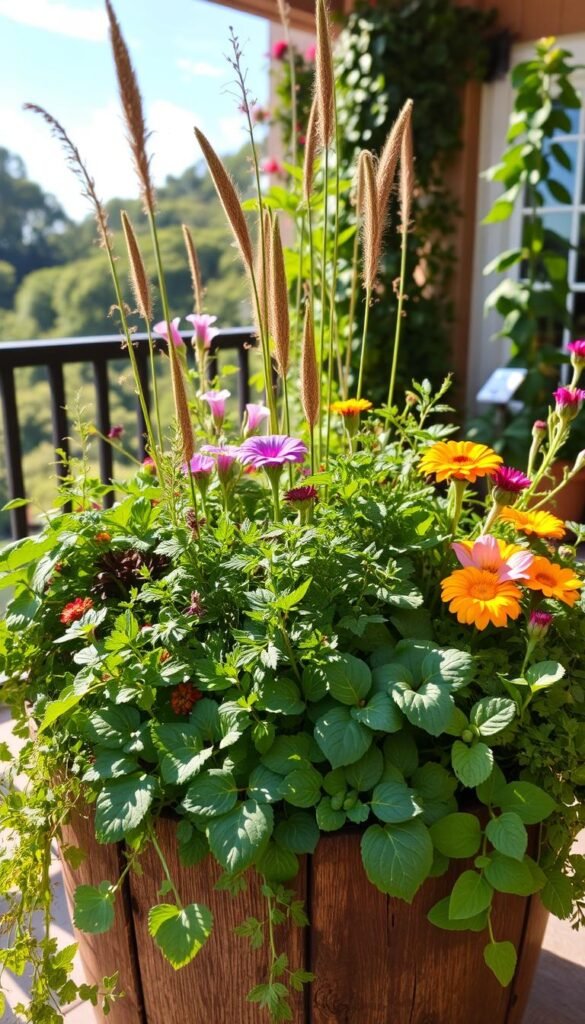Got limited space but big gardening dreams? Let’s talk about pairing greens that thrive together in pots. Whether you’re growing herbs on a balcony or veggies by a sunny window, smart pairings can boost your harvests while saving room.
This method isn’t just about looks. When certain species grow side by side, they naturally support each other. Some repel pests, while others share nutrients efficiently. Think tomatoes with basil—the basil helps deter bugs, and both love similar soil conditions.
Even small containers can become mini ecosystems. The Permaculture Apartment Garden Design Workbook shows how to layer plants for maximum efficiency. Imagine mixing leafy greens with shallow-rooted flowers—they’ll use different soil depths without competing.
Struggling with tricky corners or uneven light? We’ll share combinations that adapt to your unique setup. From spicy peppers paired with marigolds to aromatic herbs mingling with lettuce, you’ll discover how to create harmony in tight spaces.
Ready to turn your pots into power teams? Keep reading for actionable tips and science-backed duos that make every inch count. No guesswork—just greener thumbs and happier harvests.
Understanding Companion Planting in Container Gardens
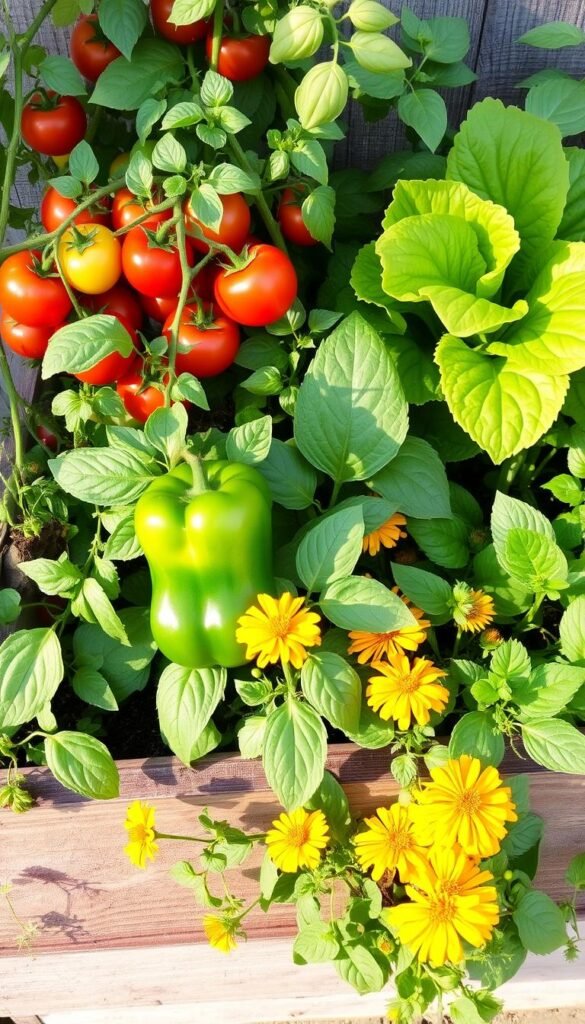
Unlock the secrets of thriving potted gardens through strategic plant partnerships. When species grow together, they form natural alliances—some attract pollinators while others suppress pests. This approach works like a mini support system, especially when working with confined areas.
Benefits of Strategic Pairings
Certain combinations create win-win scenarios. Marigolds release compounds that repel harmful insects, protecting nearby vegetables like tomatoes. Herbs such as oregano improve soil quality by preventing erosion in shared pots. Unlike traditional gardens, containers let you control micro-environments precisely.
Working With Tight Quarters
Limited root depth requires smart planning. Shallow-rooted lettuce pairs well with deeper-rooted carrots—they access nutrients at different levels. Use this table to compare ground vs. container setups:
| Factor | Ground Gardens | Containers |
|---|---|---|
| Root Space | Unrestricted | Requires layering |
| Water Retention | Natural drainage | Frequent monitoring |
| Pest Control | Wider spread | Easier to manage |
Choose wider pots for plants sharing resources. Test pairings like basil with peppers—their growth habits complement each other. Adjust watering schedules since confined soil dries faster. With experimentation, you’ll find what thrives in your unique setup.
Choosing the Right Plants for Container Gardening Success
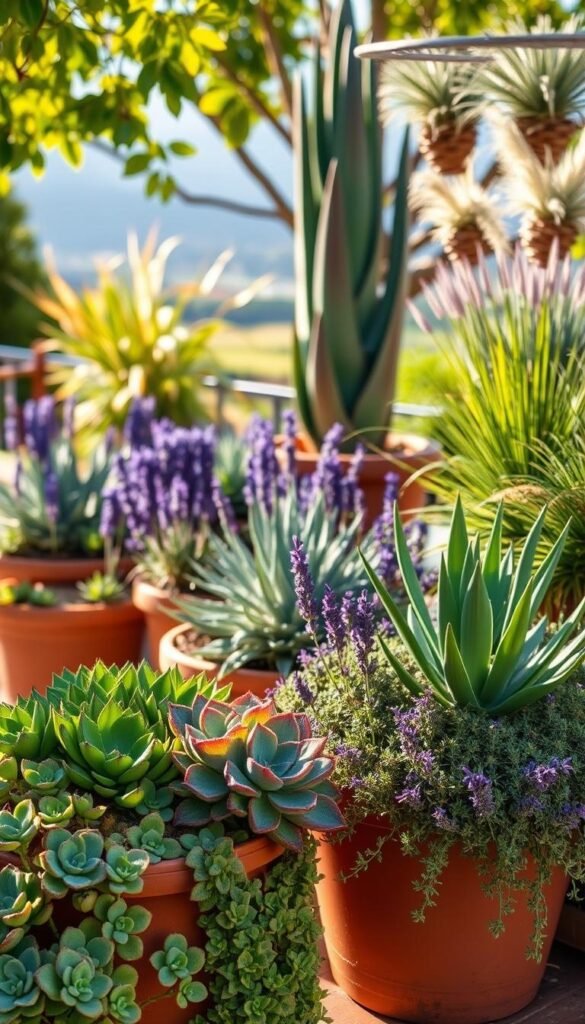
Maximize your container garden’s potential by matching greenery to your specific conditions. Start by observing your space for a week—track how sunlight moves and where shadows fall. Most edibles need 6+ hours of direct light daily, while leafy greens tolerate partial shade.
Assessing Your Container’s Light and Water Needs
South-facing balconies suit sun-loving tomatoes and peppers, while herbs like mint thrive in east-facing spots with morning light. Use your hand to test soil moisture—if it feels dry two inches down, it’s time to water. Pair species with similar hydration needs, like rosemary and lavender, to prevent overwatering.
Matching Plant Growth Requirements
Combine shallow-rooted lettuce with deep-rooted carrots to optimize space. Avoid overcrowding by checking mature sizes—a 12-inch pot fits one tomato plant plus basil. For nutrient harmony, group heavy feeders like kale with light feeders like radishes. Explore compact vegetables that adapt well to confined areas.
Tomatoes and basil aren’t just culinary buddies—they share warmth and drainage preferences. Use well-aerated soil with perlite to support root health. Adjust groupings seasonally; spinach thrives in cool spring containers but bolts in summer heat. With thoughtful pairing, your pots become high-yield mini ecosystems.
Best Companion Plant Pairings for Container Gardening

Transform your patio pots into powerhouse gardens with science-backed plant teams. Expert-tested combinations help your greenery share resources while keeping pests at bay. Let’s explore pairings that turn cramped quarters into productive spaces.
Proven Container Combinations
Try these winning teams tested by urban gardeners. The classic tomato-basil duo works because basil masks tomato plants’ scent, confusing pests. For a three-sisters adaptation, pair pole beans (nitrogen fixers), dwarf corn (support), and squash (ground cover) in extra-large planters.
| Plant Pair | Benefits | Container Size |
|---|---|---|
| Tomato + Basil | Pest protection, flavor boost | 18″ diameter |
| Peppers + Garlic | Fungus prevention | 14″ deep |
| Cucumbers + Dill | Attracts pollinators | 20″ wide |
Building Balanced Plant Teams
Follow these rules for happy cohabitants. Match root depths—pair radishes (shallow) with carrots (deep). Balance feeders: heavy eaters like kale need light partners like onions. Always leave 2″ between stems for air flow.
Herbs like rosemary make great border plants in shared pots. Their strong scents deter aphids naturally. For a great way to start, try one edible + one pest-repelling flower in each container.
Rotate pairings seasonally. Cool-weather spinach thrives with chives, while summer eggplant pairs well with marigolds. Track what works in your space—every balcony has unique light and wind patterns!
Designing Your Container Garden Layout
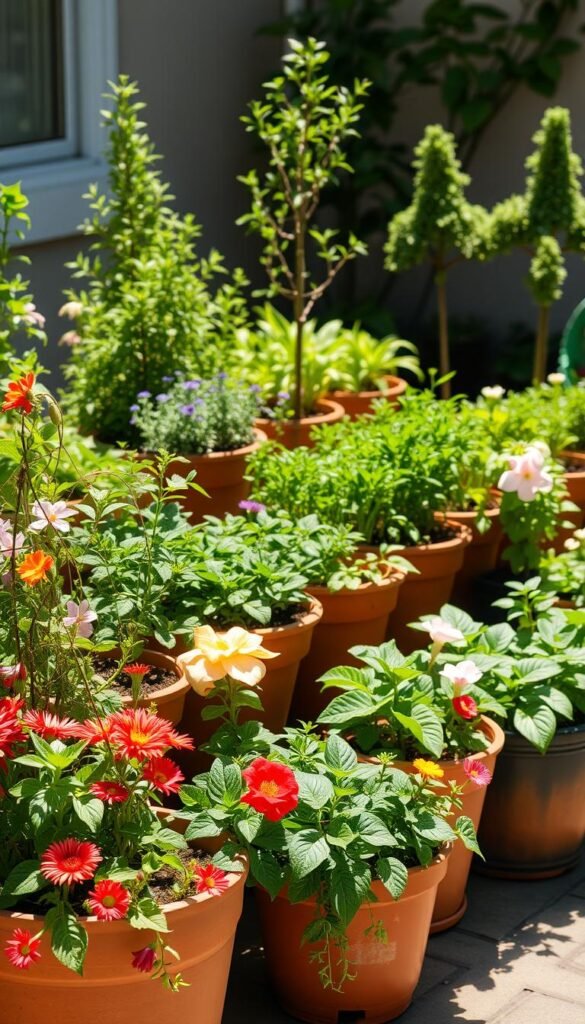
Turn cramped balconies into lush, productive spaces by reimagining your pot arrangements. Smart designs blend beauty with efficiency, letting you grow more in less room. Start by sketching your area—note sunny spots, shaded corners, and walkways.
Utilizing Space with Creative Layouts
Stack pots vertically using shelves or hanging planters. Try these ideas:
- Tiered stands: Place trailing nasturtiums under tall peppers to cover bare soil
- Corner clusters: Group mint, chives, and pansies in triangular formations
- Wall pockets: Mount shallow planters for herbs like thyme or oregano
Rotate containers weekly so all sides get light. Use narrow tables between railings for extra surface area. Even a 2’x2’ balcony can host 10+ plants with layered setups.
Incorporating Permaculture Principles
Follow the Permaculture Apartment Garden Design Workbook to create self-sustaining systems. Layer plants like a forest ecosystem:
- Canopy: Dwarf fruit trees (lemon, fig)
- Understory: Bush beans or determinate tomatoes
- Ground cover: Creeping thyme or microgreens
Place water-loving species near self-watering pots. Use mulch to retain moisture and reduce upkeep. Your tiny garden becomes a living cycle—flowers feed pollinators, herbs repel pests, and veggies feed you.
Tips to Enhance Growth and Manage Pests
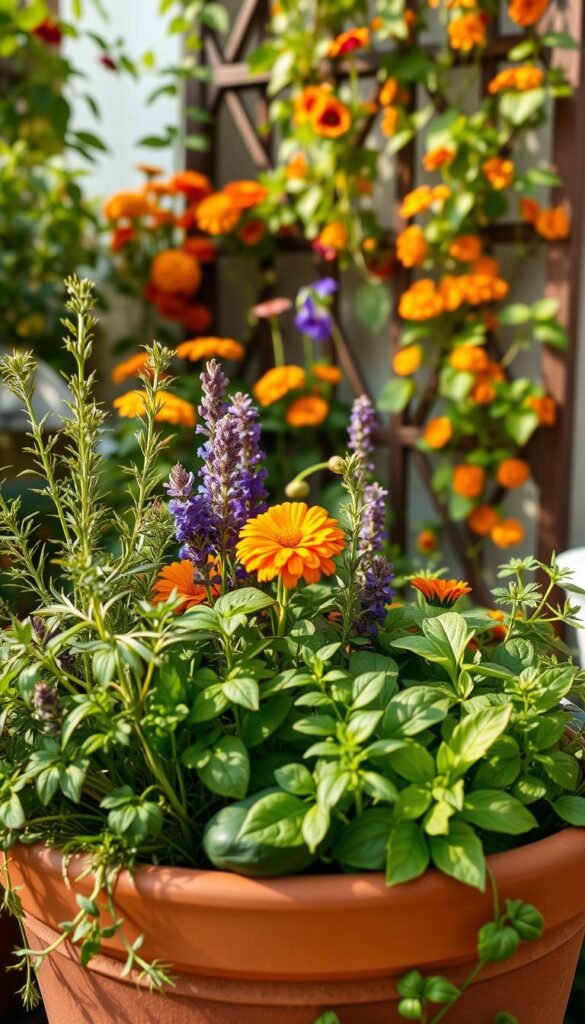
Elevate your container garden’s health and productivity with smart, natural strategies. By combining pest-deterring plants with soil-boosting techniques, you’ll create a thriving ecosystem that resists insects while maximizing yields. Let’s explore how to balance these elements for vibrant, chemical-free results.
Leveraging Natural Pest-Repelling Plants
Chives are a secret weapon against aphids and Japanese beetles. Their onion-like scent masks the aroma of vulnerable companion plants like tomatoes. Pair them with garlic or marigolds—their strong fragrances confuse pests while adding visual appeal.
Rosemary and basil also deter unwanted visitors. These herbs release oils that repel mosquitoes and spider mites. Tuck them between leafy greens or flowering annuals for dual-purpose beauty and protection.
Optimizing Soil Quality and Watering Techniques
Healthy soil starts with compost tea or worm castings. These amendments boost microbial activity, helping roots absorb nutrients efficiently. Mix in perlite for drainage—containers dry out faster than garden beds, so watering consistency matters.
Check moisture daily by sticking your finger 2 inches deep. Group plants with similar hydration needs—lavender and thyme prefer drier conditions, while lettuce and spinach thrive in damp soil. A drip irrigation system ensures even water distribution without over-saturating roots.
For more companion planting in containers insights, track how your pairings perform over time. Adjust your approach based on what your green team shows you—every season brings new opportunities to refine your strategy!
Experimenting with Popular Pairings and New Combinations
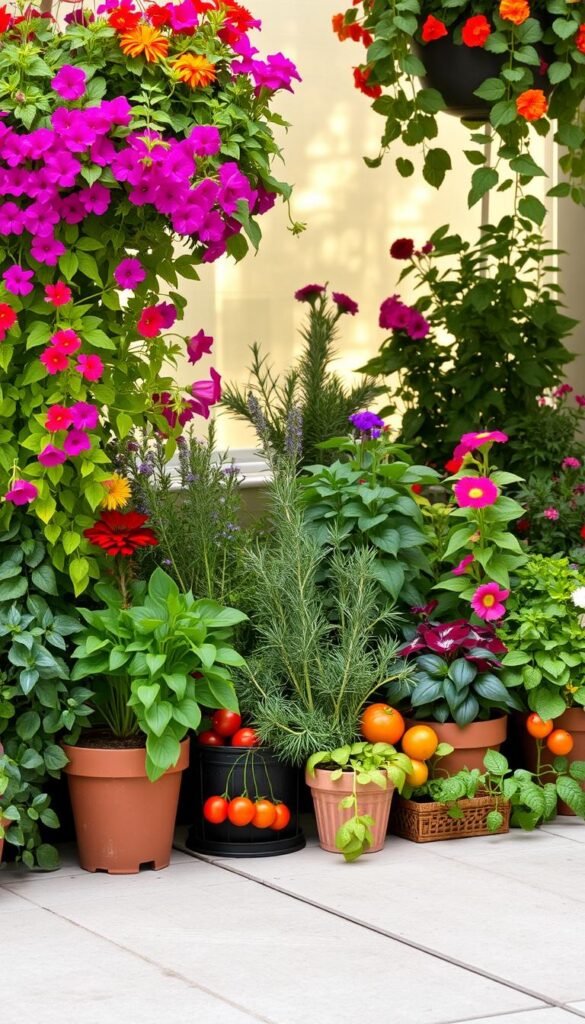
Discover how proven plant partnerships can transform your container setups. Urban growers like Jenna from Seattle share: “My tomatoes doubled in size after adding basil—the leaves stayed pest-free all summer.” These success stories reveal why certain duos outperform solo plants.
Success Stories: Tomato and Basil
This classic combo isn’t just for pasta sauce. Basil emits compounds that mask tomato scents, confusing aphids and whiteflies. One gardener reported 63% fewer pests compared to isolated tomato pots. They also share soil preferences—both thrive in slightly acidic, well-drained mixes.
Mixing Greens: Lettuce, Spinach, and Arugula
Grow a salad bowl in one pot! These leafy greens have shallow roots and mature at different rates. Spinach bolts first, making space for slower-growing arugula. Use a 14″ wide planter and stagger planting dates for continuous harvests.
Try these tested mixes:
- Cherry tomatoes + parsley (attracts hoverflies)
- Kale + nasturtiums (deters cabbage worms)
- Strawberries + thyme (prevents fungal issues)
Over 80% of gardeners in a recent poll said experimenting boosted their yields. Start with one unconventional pair—like radishes and marigolds—and track results. Share your discoveries in the comments below. Who knows? Your mix might become the next big trend!
Creating Variety with Herbs and Flowers
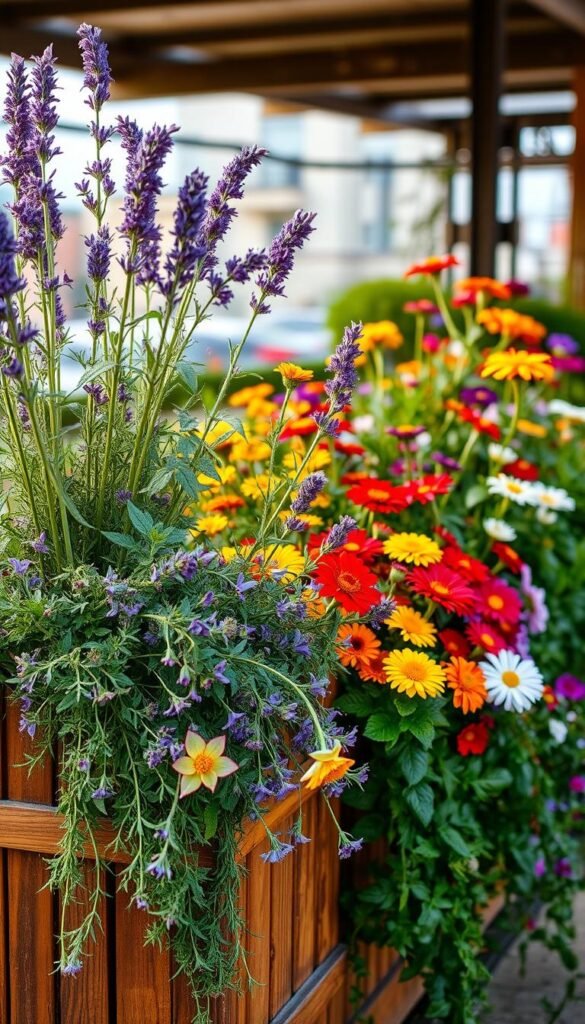
Spice up your container garden with a colorful mix of herbs and blooms—they’re not just pretty faces! These dynamic pairings add visual flair while serving practical purposes. According to urban gardening experts, blending aromatic greens with vibrant petals creates mini ecosystems that boost yields and deter pests naturally.
Flavor Boosters and Pest Patrol
Basil does double duty—its fragrant leaves enhance tomato dishes while repelling flies and mosquitoes. Rosemary’s pine-like scent confuses carrot flies, protecting nearby root vegetables. Try these combos in 12″ pots:
| Herb | Flower Partner | Benefits |
|---|---|---|
| Thyme | Calendula | Attracts ladybugs, deters beetles |
| Oregano | Nasturtium | Traps aphids, edible blooms |
| Chives | Marigold | Repels nematodes, adds onion flavor |
Bright blooms like zinnias and cosmos draw bees and butterflies, increasing pollination for your peppers and beans. Interplant them with parsley or cilantro—their umbrella-shaped flowers feed beneficial insects.
Stagger plantings every 2-3 weeks for nonstop harvests. Snip basil tops to encourage bushiness, and let some cilantro bolt for lacy white flowers. Experiment with lemon balm or pineapple sage in warmer climates—their citrusy notes jazz up summer drinks while masking veggie scents.
A lively mix of purple sage, yellow marigolds, and red-stemmed chard turns functional planting into living art. You’ll enjoy fresh flavors, fewer bugs, and a balcony that’s equal parts pantry and paradise.
Wrapping Up Your Container Garden Journey
Your container garden journey doesn’t end here—it’s just getting started! By pairing plants strategically, you’ve learned to maximize space while creating natural defenses against pests. Combinations like tomatoes with basil or peppers with marigolds prove that smart companion planting works wonders in tight quarters.
Remember to match light and soil needs when grouping species. Shallow-rooted greens thrive alongside deeper-rooted veggies, letting you grow more in one pot. Don’t forget to revisit our tips on vertical layouts and bright blooms to elevate your balcony’s beauty and function.
Over the years, keep refining your approach. Track which pairings yield the best harvests and share your discoveries in the comments. Every trial teaches something new—whether it’s managing insects with chives or boosting tomato growth through clever root spacing.
This is your great way to connect with the gardening world, one container at a time. Now grab those pots, mix bold combinations, and watch your mini ecosystem flourish!

